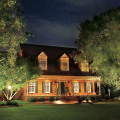Laying out landscape lighting effectively requires a blend of artistic vision and technical precision to enhance the beauty of outdoor spaces while ensuring functionality and safety. The first step in this process involves assessing the area to be illuminated, considering factors such as existing landscaping features, pathways, architectural elements, and areas requiring security or accent lighting. A well-thought-out plan balances aesthetics with practicality, ensuring that lighting serves both to beautify the space and to provide necessary illumination for safety and usability after dark.
To begin, identify key features in the landscape that would benefit from lighting, such as trees, garden beds, water features, and architectural details of the home. These elements can be highlighted using various lighting techniques such as uplighting, downlighting, spotlighting, and silhouette lighting, each creating different effects and moods in the garden. Pathways, steps, and driveways require careful consideration to ensure they are well-lit, providing safe passage while complementing the overall design. This is where a mixture of path lights, step lights, and bollard lights can be employed to guide the way while adding an aesthetic touch.
When laying out the lighting, it's crucial to consider the viewpoint from both inside and outside the home. Lighting should be designed to be enjoyed from the interior of the house, creating a picturesque view out of windows and glass doors, as well as from various points in the garden itself. The play of light and shadow can create depth and interest, enhancing the natural beauty of the outdoor space.
Energy efficiency and control are also important aspects of landscape lighting. LED lights are a popular choice due to their long life and low energy consumption. Incorporating timers, dimmers, and motion sensors can further enhance energy efficiency and provide flexibility in how the lighting is used, adapting to different needs and occasions.
Integration with the existing landscape is key to achieving a seamless look. Cables and fixtures should be discreetly placed to avoid detracting from the garden's natural beauty. Strategic placement of lights can also help to avoid light pollution, ensuring that the lighting enhances rather than overwhelms the space.
Collaborating with professionals can greatly enhance the outcome of a landscape lighting project. For instance, when incorporating concrete elements into the landscape, consulting with experts like Toowoomba Concreters - Click here, can provide valuable insights into integrating lighting within these features for a cohesive and stunning effect. Their expertise in concrete applications can complement the lighting design, from embedding lights into concrete paths and patios to highlighting architectural concrete elements, ensuring durability and style.






